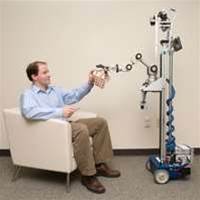
The four-year Cogniron project aims to resolve some of the key issues in the development of cognitive robot companions which could be used as assistants for disabled and elderly people or the general population.
The project has been funded since January 2004 by the European Union's IST Future and Emerging Technologies initiative.
"The example that's often used is a robot that's able to fulfil your needs, like passing you a drink or helping in everyday tasks," said Dr Raja Chatila, research director at the Systems Architecture and Analysis Laboratory of the French Centre National de la Recherche Scientifique, and Cogniron project coordinator.
"That might seem a bit trivial, but let me ask you a question: In the 1970s, what was the use of a personal computer?"
The key issue governing these tasks is intelligence and developing intelligent behaviour on a number of fronts, which is described as the cornerstone of the Cogniron project.
Organised around seven key research themes, the project studies 'multimodal dialogues', 'detection and understanding of human activity', 'social behaviour and embodied interaction', 'skill and task learning', 'spatial cognition and multimodal situation awareness' and 'intentionality and initiative'.
The seventh research theme, 'system level integration and evaluation', focuses on integrating the other themes into a cohesive, cogitating whole.
Decision-making is a fundamental capability of a cognitive robot whether for autonomous deliberation, task execution or human/robot collaborative problem solving.
It also integrates the three other capacities: interaction, learning and understanding the environment.
"Getting a robot to move around a human without hurting them, and while making them feel comfortable, is a vital task," said Dr Chatila.
He explained that, for this to work, a robot must pick up subtle cues. If, for instance, a human leans forward to get up, the robot needs to understand the purpose of that movement.
What's more, much of human communication is non-verbal, and such cognitive machines need to pick up on this if they are to be useful, rather than irritating.
To tackle the problems, the researchers took inspiration from natural cognition as it occurs in humans, which is one reason why a cognitive robot companion needs to be able to learn.
Dr Chatila said that the project has got off to "a promising start" but it will be a very long road before a fully functional cognitive robot companion will be realised and commercialised.

_(20).jpg&h=140&w=231&c=1&s=0)
_(22).jpg&h=140&w=231&c=1&s=0)





_(26).jpg&w=100&c=1&s=0)

 iTnews Executive Retreat - Security Leaders Edition
iTnews Executive Retreat - Security Leaders Edition











_(1).jpg&h=140&w=231&c=1&s=0)



